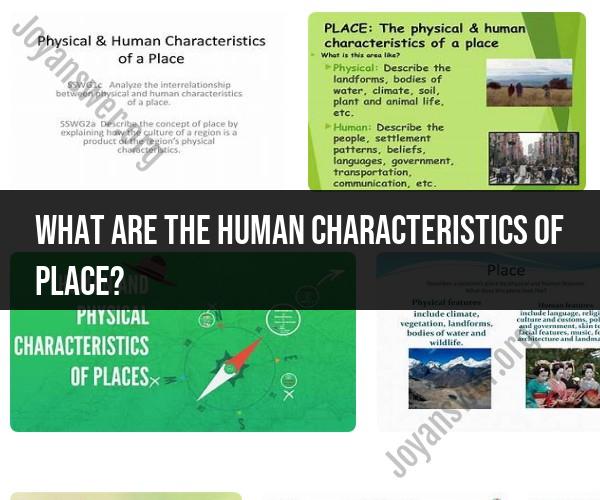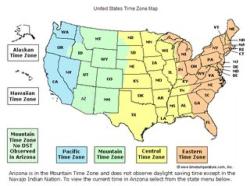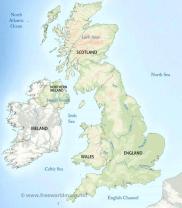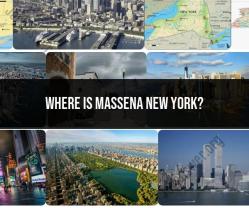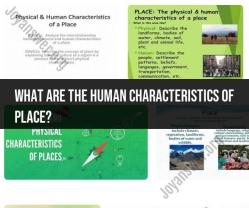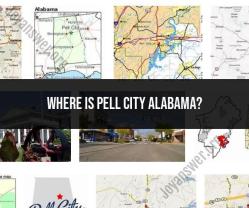What are the human characteristics of place?
In geography and human geography, the concept of "human characteristics of place" refers to the aspects of a location or region that are shaped by human activities and interactions. These characteristics help define the cultural, social, economic, and political attributes of a place. Human characteristics of place can vary widely from one location to another. Some key human characteristics of place include:
Population Density: The number of people living in a particular area is a crucial human characteristic. High population density areas tend to have more urbanization and infrastructure, while low-density areas may be rural or sparsely populated.
Cultural Heritage: The cultural characteristics of a place encompass its traditions, customs, languages, religions, art, music, and other aspects of its cultural identity. Cultural heritage can vary significantly from one place to another, contributing to its uniqueness.
Economic Activities: The types of economic activities in a region, such as agriculture, manufacturing, services, or technology, greatly influence its character. Economic activities can determine a place's level of prosperity, employment opportunities, and industry specialization.
Architecture and Urban Design: The design of buildings, infrastructure, and urban spaces reflects the historical, cultural, and economic context of a place. Different architectural styles and city layouts can be seen as human characteristics.
Political Organization: Political boundaries, government structures, and administrative divisions shape the governance of a place. They can include the presence of local, regional, and national authorities.
Land Use: How land is utilized—whether for residential, commercial, industrial, agricultural, or recreational purposes—defines the function and appearance of an area.
Education and Healthcare: Access to education and healthcare services is a vital aspect of human well-being. The presence and quality of schools, colleges, universities, and medical facilities contribute to the character of a place.
Social Services and Infrastructure: Availability of social services like housing, transportation, sanitation, and utilities (water, electricity, and telecommunications) plays a significant role in shaping the living conditions in a place.
Cultural Institutions: The presence of cultural institutions such as museums, theaters, libraries, and galleries enriches a place's cultural life and offers opportunities for community engagement.
Historical Significance: Historical events, landmarks, and monuments can define the historical character of a place. Sites of historical significance often attract tourism and play a role in local identity.
Social Demographics: The composition of the population in terms of age, gender, ethnicity, and socioeconomic status influences the social dynamics and character of a place.
Environmental Impact: Human activities can have a significant impact on the natural environment, affecting factors like air and water quality, land use, and biodiversity. These environmental characteristics are intertwined with human characteristics.
Community and Social Life: The strength and vibrancy of community life, including social organizations, clubs, and local events, contribute to the social fabric of a place.
Economic Opportunities: Job opportunities, wages, and the availability of businesses and industries are key factors that influence the economic well-being of a place and the opportunities available to residents.
Understanding the human characteristics of place is essential for geographers, urban planners, policymakers, and researchers, as it helps explain the diverse and dynamic nature of human settlements and regions around the world. These characteristics provide insights into the unique identity and challenges faced by different places and can guide decision-making for sustainable development and improvement of living conditions.
Exploring the Human Characteristics of Place
Place is a complex concept that encompasses both physical and human characteristics. Physical characteristics include the natural environment, such as the landforms, climate, and vegetation. Human characteristics include the built environment, such as the buildings, roads, and other infrastructure. Human characteristics also include the culture, history, and traditions of the people who live in a place.
The human characteristics of place are what make places unique and give them meaning. They are what create a sense of place attachment and identity.
Place Identity: Understanding Human Connections to Locations
Place identity is the feeling of connection that people have to a particular place. It is shaped by a variety of factors, including the physical environment, the built environment, culture, and personal experiences.
Place identity is important because it can provide people with a sense of belonging, meaning, and purpose. It can also motivate people to protect and care for the places they identify with.
The Essence of Place: Human-Centric Characteristics
The human characteristics of place are the essence of what makes a place unique and meaningful. They are the things that give a place its character and that people identify with.
Some examples of human characteristics of place include:
- Culture: The culture of a place includes the language, religion, customs, and traditions of the people who live there.
- History: The history of a place includes the events and people that have shaped it over time.
- Architecture: The architecture of a place reflects its history and culture.
- Art: The art of a place reflects its unique perspective and creativity.
- Food: The food of a place is often a reflection of its culture and its natural environment.
- People: The people of a place are what make it special. They are the ones who create and maintain its culture and identity.
The human characteristics of place are important because they make places more than just physical locations. They give places meaning and make them special to the people who live there.
Here are some examples of how human characteristics of place can impact people's lives:
- Culture: The culture of a place can influence people's values, beliefs, and behaviors. For example, people who live in cultures that place a high value on collectivism may be more likely to cooperate with others and to be less individualistic.
- History: The history of a place can shape people's sense of identity and belonging. For example, people who live in places with a long history of social justice activism may be more likely to be politically engaged and to advocate for social change.
- Architecture: The architecture of a place can influence people's mood and emotions. For example, people who live in places with a lot of green space and natural light may be more likely to feel happy and healthy.
- Art: The art of a place can inspire people and help them to connect with others. For example, people who live in places with a vibrant arts scene may be more likely to be creative and to appreciate different cultures.
- Food: The food of a place can bring people together and create a sense of community. For example, people who live in places with a diverse culinary scene may be more likely to be open to new experiences and to meet people from different backgrounds.
- People: The people of a place can make a difference in people's lives. For example, people who live in places with a strong sense of community may be more likely to feel supported and connected to others.
The human characteristics of place are important because they make places more than just physical locations. They give places meaning and make them special to the people who live there.
